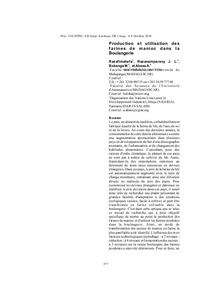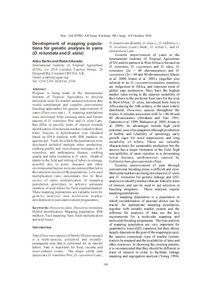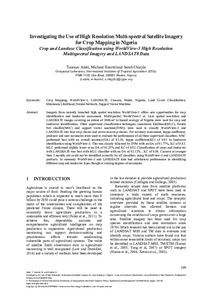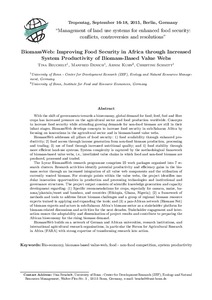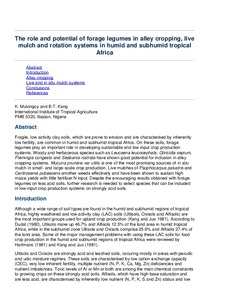Welcome to the International Institute of Tropical Agriculture Research Repository
Conference Documents: Recent submissions
Now showing items 301-320 of 597
-
Out scaling of improved cassava processing technology - Uganda lessons
(International Society For Tropical Root Crops-Africa Branch, 2012-02)Cassava (Manihot esculenta Crantz) has an immediate potential for use in food and feed industry in East and Central Africa (ECA). However, its industrial utilization in the region remains low, partly due to lack of improved processing technologies, lack of awareness of the alternative uses of cassava and technical know how for commercialization. To tap the potential of cassava in feed industry of Uganda, EARRNET and its partners, NARO, Ugachick and farmers, established in 2005 two pilot processing ... -
Lessonslearntand perspectives from a global effort to support the deployment of underutilized species, with special reference to documentation of knowledge and information
(Bioversity International, 2012)This paper focuses on the role of the Global Facilitation Unit for Underutilized Species in the promotion and facilitation of the sustainable deployment of underutilized plant species to increase the security of food and nutrition and alleviate poverty among poor rural and urban communities. -
Production et utilisation des farines de manioc dans la Boulangerie
(ISTRC-AB, 2012-02)Le pain, un aliment de tradition, est habituellement fabriqué à partir de la farine de blé, de l'eau, du sel et de la levure. Au cours des dernières années, la consommation de cette denrée alimentaire a connu une augmentation spectaculaire dans plusieurs pays en développement du fait d'une démographie montante, de l'urbanisation et du changement des habitudes alimentaires. Cependant, pour des raisons d'ordre climatique, la plupart de ces pays ne sont pas à même de cultiver du blé. Aussi, dépendent-ils ... -
Development des moyens de lutte contre le « Shimbu », cas de la culture du manioc au kasai oriental/RDC: Revue et contribution sur les moyens de lutte contre le complexe parasitaire shimbu
(International Society For Tropical Root Crops-Africa Branch, 2012-02)L'interaction des plusieurs contraintes, à savoir les maladies et ravageurs du manioc, les pratiques culturales inadéquates, la faible fertilité des sols, etc. contribuent à la baisse de la productivité du manioc. Il a été constaté à Luputa et Ngandajika que les champs des agriculteurs y compris les champs de manioc sont souvent infestés par un complexe maladie/ravageur localement appelée « shimbu ». Cette revue a pour objectif l'inventaire des connaissances et des différents moyens de lutte existants ... -
Using steam to dry food: introducing the (UPoCA) dryer
(International Association of Hydrological Sciences, 2012-02)The production of cassava flour involves drying grated and pressed cassava into pellets that are milled into flour. The drying process is one of the major bottlenecks to expanding the economic value of the crop. The industry looks for fast drying systems with high flour production capacity to meet market demands. Traditional sun-drying is limited by rainfall, and conventional drying systems are based on motorized machinery unsuitable for farm gate use. The UPoCA dryer has been developed to address ... -
Unleashing the power of cassava in Africa…are we there yet?
(International Society For Tropical Root Crops-Africa Branch, 2012-02)Cassava has long been expected to play a key role in rural economic growth in Africa, but has it happened yet? Although research partnerships have produced elite cassava varieties with 50% more yield potential and have demonstrated technologies to improve processing and increase marketing of cassava, the sub sector is constrained by low productivity and marketing difficulties. In DR Congo, Ghana, Malawi and Sierra Leone, for example, the actors in the cassava value chain are yet to respond to trade ... -
Development of mapping populations for genetic analysis in yams (D. rotundata and D. alata)
(International Association of Hydrological Sciences, 2012-02)Progress is being made at the International Institute of Tropical Agriculture to develop molecular tools for marker-assisted selection that would complement and expedite conventional breeding approaches for genetic improvement of yams (Dioscorea spp.). F mapping populations 1 were developed from crossing male and female parents of D. rotundata Poir. and D. alata Lam. that differ in specific traits of interest towards identification of molecular markers linked to those traits. Success in hybridization ... -
Impact of inadequate regulatory frameworks on the adoption of bio-fertilizer (eg PGPR) technologies: a case study of sub-Saharan Africa
(Asian PGPR Society for Sustainable Agriculture, 2013)Recently, there has been a lot of interest to promote bio-fertilizers for eco-efficient intensification of agricultural systems in sub-Saharan Africa (SSA). Bio-fertilizers are considered cost-effective and environmentally-friendly. In SSA, bio-fertilizers have not been sufficiently evaluated for quality and efficacy because of weak or absence of regulatory frameworks. Consequently, a proliferation of low quality and inefficacious bio-fertilizer products has been reported. Based on a stepwise ... -
Discovery of Single Nucleotide Polymorphisms (SNPs) as a tool for markerassisted breeding of cassava, Manihot esculenta
(International Association of Hydrological Sciences, 2012-02)Discovery of single nucleotide polymorphisms, (SNPs) as a tool in marker-assisted breeding of cassava, Manihot esculenta was studied. The principal objective of this study is to discover single nucleotide polymorphisms (SNPs) in some panels of elite lines (ELs) of cassava and in some mapping populations to be used as a tool for marker-assisted breeding in cassava (Manihot esculenta). As a nucleotide base constitutes genetic information for inheritance, SNPs provide the ultimate form of molecular ... -
Economic damages of cassava brown streak disease in sub-Saharan Africa: a framework
(International Society For Tropical Root Crops-Africa Branch, 2012-02)Cassava brown streak disease (CBSD) remains a major threat to the livelihoods of millions of smallholders in sub-Saharan Africa. This viral disease was initially confined to the coastal lowland areas of eastern and southern Africa. More recently there has been a major new outbreak in the Great Lakes region of eastern and central Africa, and two virus species have been shown to cause the disease. This paper describes a framework that could be used to make a meaningful assessment of economic damages ... -
Sensory, nutritional and antioxidant properties of tuwo (rice-based food dumpling) supplemented with soybean flour
(The International Union of Food Science and Technology (IUFoST), 2016-08) -
Investigating the use of high resolution multi-spectral satellite imagery for crop mapping in Nigeria crop and landuse classification using WorldView-3 high resolution multispectral imagery and LANDSAT8 data
(2016)Imagery from recently launched high spatial resolution WorldView-3 offers new opportunities for crop identification and landcover assessment. Multispectral WorldView-3 at 1.6m spatial resolution and LANDSAT8 images covering an extent of 100Km² in humid ecology of Nigeria were used for crop and landcover identification. Three supervised classification techniques (maximum likelihood(MLC), Neural Net clasifier(NNC) and support vector machine(SVM)) were used to classify WorldView-3 and LANDSAT8 into ... -
Increasing smallholders' intensity in cassava value web: effect on household food security in Southwest Nigeria
(2015-09-16)Although cassava production and processing is on the increase in Nigeria, there is still a large gap to be filled in meeting the food and raw material need of the country in terms of cassava products and by-products. The reported increase in area cultivated with cassava has not been translated to higher resource use efficiency or productivity, thus cassava smallholders have low physical and economic returns on their activities. This has serious implications for their well-being attributes, chiefly ... -
Potassium deficiencies limit common bean (Phaseolus vulgaris L.) production in West Usambara, Northern Tanzania
(International Potash Institute, 2015-07)Common bean (Phaseolus vulgaris L.) is the most important food grain legume crop in west Usambara highlands, but its yield remains below the potential largely due to nutrient deficiencies in the soils. To identify nutrients limiting bean production, on-farm diagnostic trials were carried out at nine farmer fields around Lushoto town in the short rainy season (vuli) from November 2013 until February 2014, though soil and leaf sample analyses. Bean leaf samples were analysed for macro and micronutrients, ... -
Residual benefits of two cowpea genotypes and natural fallow to subsequent maize in the northern Guinea savanna of Nigeria
(Centro Internacional de Agricultura Tropical (CIAT), Tropical Soil Biology and Fertility (TSBF), 2007) -
Biological nitrogen fixation by rhizobia and mineral fertilizer savings: implications for green revolution in Africa
(Centro Internacional de Agricultura Tropical (CIAT), Tropical Soil Biology and Fertility (TSBF), 2007) -
Optimizing the contribution of cowpea to food and fodder production in crop-livestock systems in West Africa
(International Grassland Society, 1997)Cowpea is important for the provision of both grain for food and fodder for livestock but there is often a trade-off between production of the two. To better understand influences on grain and fodder production, and how these may be utilized. Research was conducted at 5 locations in West Africa using 12 cowpea varieties, with and without insecticide spray. Spraying had a dramatic effect on grain production, but less so for fodder, however there was an effect of spraying on fodder quality in terms ... -
The role and potential of forage legumes in alley cropping live mulch and rotation systems in humid and subhumid tropical Africa
(ILCA, 1986)Discusses the role and potential of forage legumes in alley cropping, live mulch and in situ mulch systems in humid and subhumid tropical Africa. Examines forage legume species for alley cropping; nutrient contribution from leguminous trees and shrubs grown in hedgerows, forage legume in situ and live mulches, soil restorative and protective value of in situ and live mulches, nitrogen fixation and nitrogen contribution, effects on nematodes, weeds, and crop yield. -
Cowpea as a key factor for a new approach to integrated crop-livestock systems research in the dry savannas of West Africa
(IITA, 2002)Agriculture in the dry savannas is intensifying in response to increasing populations of humans and livestock. As a result, increased productivity demands are placed upon integrated crop-livestock systems and more emphasis is on the roles of legumes such as cowpea. Cowpea has the potential to function as a key integrating factor in intensifying systems through supplying protein in the human diet, and fodder for livestock, and bringing nitrogen into the farming system through nitrogen fixation. ...


